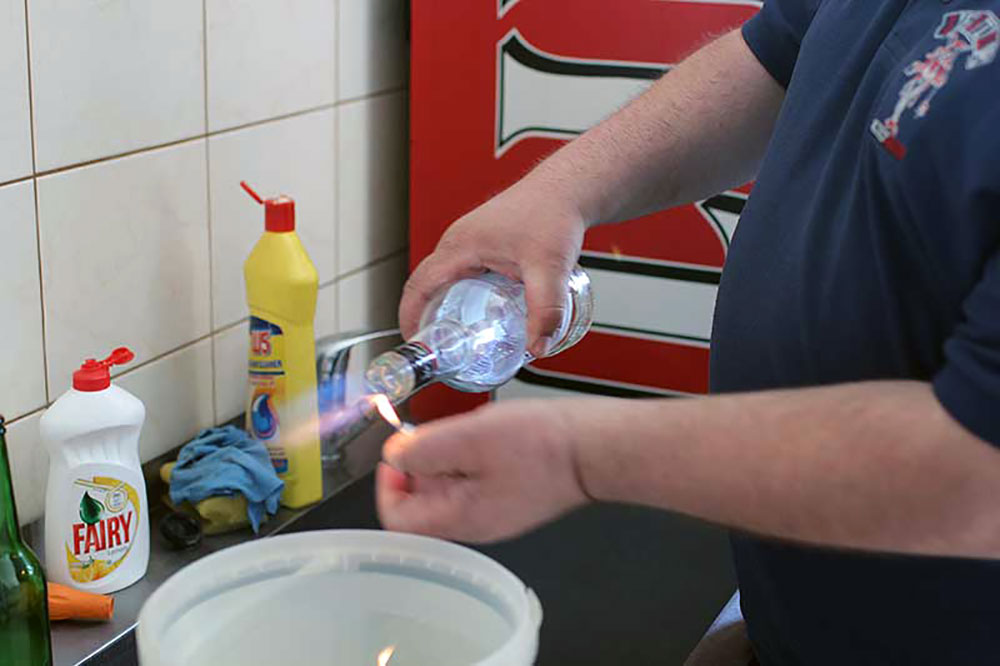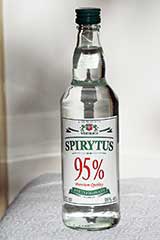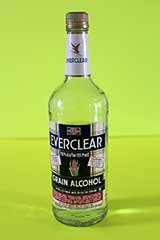Meats and Sausages
Pure Alcohol
Ethanol (pure alcohol) is a hydrophilic organic solvent, i.e. it mixes readily with water and various water solutions like sugar syrup, but it will not mix directly with sugar. This statement applies to 95% pure drinking quality alcohol. The maximum strength of alcohol that can be produced by the distillation process alone is 97.2% alcohol. The remaining 2.8% water cannot be separated from alcohol as it forms with alcohol as an azeotrope.
From Wikipedia:
An azeotrope is a mixture of two or more liquids in such a ratio that its composition cannot be changed by simple distillation. This occurs because when an azeotrope is boiled, the resulting vapor has the same ratio of constituents as the original mixture.
This water can be further removed by adding chemicals, something which must not be performed by a hobbyist as a dangerous and unsafe type of alcohol may be obtained. Such 99.5% (199 proof) alcohols are added to gasoline mixtures to remove water and to increase the octane number of the fuel. The strength of alcohol influences its other characteristics such as the amount of water, boiling temperature (78.3-100° C) and specific gravity (0.794-1.0). Alcohol is an extremely volatile liquid that burns with a light bluish flame.
Alcohol Properties
The process of making flavored vodkas, infusions and liqueurs relies on mixing alcohol of varying strengths with fruits, herbs and juices. It is advisable to get familiar with properties of alcohol in order to choose the proper strength for a particular application. You can make some infusions and weak liqueurs using 40% vodka, but your choices will be severely restricted as most extracts and infusions that will become vodkas or liqueurs can only be made with stronger alcohols. Drinking quality alcohol is produced from foods that contain sugar. Fruits, grains, rice, corn, and potatoes all contain sugar which is converted into alcohol by the natural process called fermentation, the same method which has been used for thousands of years to produce wine. Originally, fermentation relied on yeasts that are naturally present in fruit; now we add commercially produced yeast which makes the process more dependable and easier to control. Industrial production is based on grains or potatoes and those raw materials contain sugar rich starches. Through the process known as "mashing" starch is converted to sugar and then fermentation breaks the sugar into alcohol and carbon dioxide. This fermented must is submitted to the distillation process and 96% (192 proof) alcohol is obtained. It is then diluted with water to 95% strength and distributed for general use.
The fermentation equation for breaking sugar:
C6H12O6 (glucose and fructose, 100 g) --> 2C2H5OH (ethyl alcohol, 51 g) + 2C2O2 (carbon dioxide, 49 g)
One may say the more sugar the fruit contains, the more alcohol will be obtained. How about fermenting pure table sugar, isn't it loaded with alcohol? Well those statements hold true, however, there are some limitations to making alcohol from heavy sugar syrup. As the yeasts produce more and more alcohol, a point is reached when the alcohol will start killing them. That may happen at around 14-18% alcohol, depending on the resistance of the yeast strain. They will die even if there is still unfermented sugar remaining in the must. This sugar will be wasted. This is the reason why we cannot produce stronger wines stronger than 16-18%, unless we add pure alcohol to them. As the majority of fruits contain between 7-12% sugar, yeast should be able to convert this sugar into alcohol. However, we often add more sugar on purpose into a wine must. The yeast will die before all the sugar can be converted into alcohol. They will sink to the bottom becoming a sediment.
Many traditional recipes call for fruit, 95% alcohol, sugar and water. Sugar and water are mixed first to create syrup and only then this syrup will combine with alcohol. However, there are different strengths of alcohol. For example if we add 390 ml of water to 1 liter of 95% alcohol, we will obtain an alcohol solution of about 70%. There is already some water present so obviously such a weaker version of alcohol can bind some sugar. Sugar has limited solubility in pure ethanol, but the 40% vodka contains 60% water and can dissolve an appreciable amount of sugar. Hence vodka may be diluted with whatever watery beverage you desire to use, in whatever proportions. If too much sugar is added, then undissolved crystals will remain. Skilled manipulation at different temperatures of the solubility properties of 40% ethanol may result in the formation of large, nicelooking sugar crystals in the bottle.
An interesting property of alcohol is it dissolves organic oils and fats. On the other hand oils and water do not mix well. You should realize that if pure alcohol was mixed with nuts it probably dissolved some oils, yet the alcohol solution is clear. We would normally make such a solution weaker by adding some water. When water is added, the alcohol may be diluted to such a degree that it can no longer hold the oil in solution. The problem may not be immediately noticeable, but in a few days the product may become cloudy. A good example is the preparation of the French aperitif Pernod. Star anise oil is diluted in 40% alcohol (vodka), forming a clear, yellow solution. When people add water to the drink a whitish emulsion of small undissolved oil drops suddenly appear making Pernod look like yellowish milk.
Alcohol Volume Contraction
Mixing water with alcohol creates a phenomenon known as volume contraction. Water molecules force their way through alcohol particles and this amount of friction generates heat and a corresponding 9-12° C increase in temperature. This also results in about a 3-5% reduction in volume. Because of this volume contraction, diluting alcohol with water does not follow linear proportions. This means that adding 1000 ml of water to 1000 ml 95% alcohol will not result in a 2000 ml solution. What we get is 1,928 ml of 45% alcohol as 72 ml has disappeared because of volume contraction. It sounds illogical but it is true and can be verified with any measuring cylinder. This "loss" is compensated by adding 72 ml water. To make matters worse alcohol is very sensitive to temperature changes and bottling alcohol at different temperatures produces different volumes which may result in a financial gain or loss for the manufacturer. Because of that the industry uses alcohol tables that provide readings of volumes of different strength alcohols at different temperatures. Make note that when you mix alcohol with water you have to deal with alcohol contraction which was explained earlier. That is why your results may slightly differ from the data in alcohol tables. Alcohol contraction is of utmost importance for commercial producers who make thousands of liters of alcohol every hour. For a hobbyist the results obtained by using the equation are fine.
Pure alcohol is made from:
- Grains - barley, corn.
- Sugar beets.
- Potatoes.
It is usually made in 95% or extremely pure 96.5% grade. The latter is used for making superior quality vodkas like Polish Wyborowa. Although distilling alcohol is illegal at home, there are many operators who make it either for their own use or for selling for profit. They usually choose sugar as the raw material for the following reasons:
- It is relatively inexpensive.
- Mixes readily with water.
- Produces plenty of alcohol.
- Using proper yeasts sugar ferments within 3 days.
- It does not require special containers.
- Does not produce heavy odors.
We are not going to go into the distillation process or into building distilling columns at home for two reasons:
- It is illegal to distill alcoholic spirits at home.
- It requires expensive equipment and a lot of outside space.
Understanding the behavior and properties of alcohol is crucial for making good spirits. Think of alcohol as a versatile tool that you use for making drinks. By intelligent manipulation of the properties of alcohol, you will create top quality drinks and you will be able to control their strengths.
USA Alcohol Restrictions
Here in the USA we have a little dilemma as far as obtaining pure alcohol is concerned. Pure, drinking quality alcohol (95%) was imported from Poland for many years. It is called "Spirytus" and it can still be obtained in some states. The same applies to American made pure alcohol (95%, 190-proof) called "Everclear®." Due to its high alcohol content, 95% Everclear and 95% Spirytus are illegal, unavailable, or difficult to find in many areas. At present, in the United States it is illegal to sell the 190-proof variety in California, Florida, Virginia, Maryland, Washington, and West Virginia. In Canada, 95% alcohol is sold in the province of Alberta, but not in most other provinces. In British Columbia it is available for purchase with a permit for medical use, research use, or industrial use only. Some municipalities, such as Chicago, have banned sales of 95% alcohol to the general public even though the state permits it to be sold. The reason is that some college students were getting dangerously drunk drinking plain 90-95% alcohol. Yes, one can drink pure alcohol and the experience should last a lifetime. It takes some skill to handle such liquor and usually newcomers are introduced to the skill by older friends. Unfortunately, some students were showing off their drinking prowess and did not realize the potency of pure alcohol. Many ended up in hospitals and that led to the ban. This miniature prohibition should not affect our efforts of making good tinctures at home as 75% (151-proof) Everclear made by Luxco is available everywhere.
From now on we will define the strength of alcohol in percent by volume (%ABV) and not in proofs as the latter method is practiced mainly in the USA. To convert percent into proof multiply by 2, for example: 40% alcohol (45%) = 40 x 2 = 80-proof. Pure drinking quality alcohol contains 95% alcohol which is equivalent to 190 proof.




















